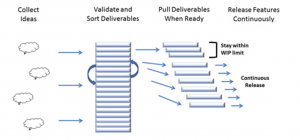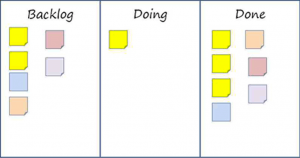Everyone probably knows how supermarket shelf packers fill the shelves. Products closest to their use-by dates are packed in front with newer products behind them. This is also known as FIFO (First In First Out). The goal is to always keep the shelves as full as possible because this is most attractive to customers. But the purchase of these products works differently, and new batches are only ordered once warehouse stock has almost been depleted. This is based on the Just-In-Time principle and is highly efficient because it works according to customer demand. As a result, there is never too much or too little. At least, that is the intention. Kanban works in this same way.

Kanban then and now
During the 1940’s, Toyota copied this supermarket trick and incorporated it into a system called Kanban. This system created an even closer connection between supply and demand and thereby improved quality and goods flow.
Kanban is Japanese for ‘sign card’. Toyota employees used these cards to visualise the steps in their processes. This resulted in better communication between teams in terms of what had to be done and when it had to be done. The system also standardised and improved processes, which led to less waste and more value.
Today, we are faced with a lots of information resources in the form of text. Consider, for example, all the emails, task lists, reports and the amount of information available on the internet. So much that we can lose track at times. The idea that a picture is worth a thousand words strongly applies here. It has even been scientifically proven that the brain first responds to illustrations. So it is no surprise that Kanban is a popular tool for use in Lean and Six Sigma.
It uses the power of visual information, created with the help of cards (e.g. post-its) on a board, to produce an image of the work. This outline creates more opportunities for intercommunication on work status and progress.

4 Principles of Kanban
More than ever, Kanban is being considered a way of implementing Agile and Lean Management methods within technical and non-technical organisations. Although many changes have taken place over the years, the below principles remain as the foundation of Kanban.
1. Visualise the work
By visualising the work and the workflow, it is possible to observe and analyse the process flow. If all available information, such as bottlenecks, waiting times, etc., is taken into account, communication and cooperation will improve.
2. Restrict ‘Work in Progress’
By restricting the amount of incomplete work, it is possible to reduce the amount of time that products spend travelling through a Kanban system. Problems caused by task switching and constant readjustment of products can also be prevented.
3. Focus on flow
By reducing the Work-in-Progress (WIP) time and compiling rules to be followed by teams, it is possible to optimise the Kanban system by improving flow. Future problems can be prevented by constantly analysing this flow.
4. Monitor, adapt and improve
When a Kanban system works well, it forms the foundation of an organisational culture that focuses on constant improvement. The effectiveness of teams can be determined by measuring and analysing the flow, quality and runtimes.

Application of Kanban
There are different ways of applying Kanban. But the goal of efficient production remains the same throughout. It describes what, when and in what amount items must be supplied, with Kanban cards playing an important role. These cards provide the signal to the relevant person who must supply the goods. Once the minimum value has been reached, a trigger (Kanban card) signals the fact that products need to be replenished. The amount of consumption therefore determines the supply.
In addition to cards, the Kanban board is another version of this system. This board uses magnets, stickers or post-its that represent the amount of work. Single items represent individual products in the process, while their positions on the board represent movement in the production process. Such a board is often divided into three columns: To do, Doing and Done. See below image.

In today’s world, the use of electronic Kanban systems is becoming more popular.




